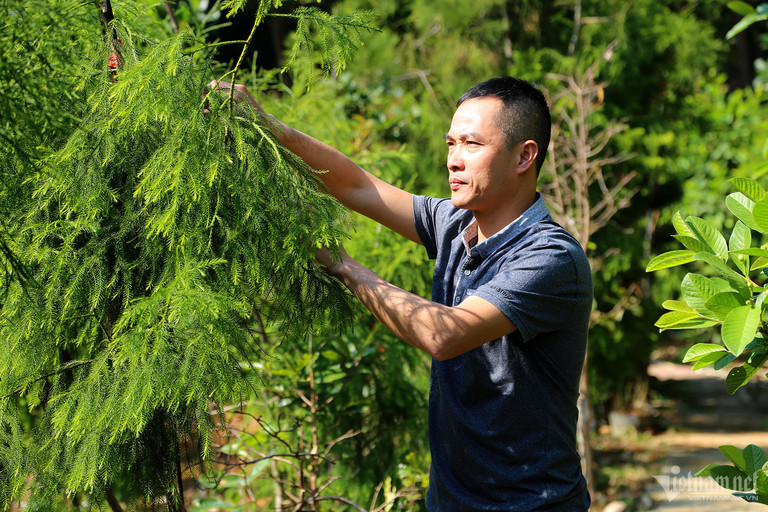
The person who picks up seeds and cares for this rare and precious tree is Pham Van Su, 43, from Thanh Son ward, Uong Bi city in QuangNinh province. He has years of experience in forestry.
In 2001, after graduating from the Faculty of Environment under the University of Natural Sciences, Su began working for the Yen Tu National Forest and Monument Management Board.
During his years of work, Su never saw descendants of more than 200 podocarp trees there grow naturally. Many ancient pine trees died every year due to pests and termites. He realized that if the situation did not improve, the rare and precious trees, hundreds of years old, would no longer exist on the sacred Buddha land.
This prompted Su to travel far and wide throughout Yen Tu thick jungles to pick up podocarp seeds when he had free time.
He looked at every ancient podocarp tree to analyze its status and realized that after falling, podocarp seeds could not hit the ground because the vegetation layer was too thick. As the seeds have an essential oil cover, that are picked up by insects as food. The seeds could not grow into seedlings.
In 2003, Su began collecting seeds of the Yen Tu ancient podocarp to propagate. At first, the germination rate was high, 80 percent, but seedlings often rotted in the roots and stems. In 2005-2008, Su successfully treated fungal diseases and reported to the leaders of the Yen Tu National Forest and Monument Management Board that he could develop the YenTu podocarp.
“"In the first years, collecting podocarp seeds was extremely difficult work because the forest roads were tough. Pine seeds only fall in the last two months of the year. Sometimes I could not collect any seeds though I spent whole days to do this,” Su recalled.
“Meanwhile, not all the seeds I collected could be used because they became rotten or were damaged, and it took many years to germinate seeds to make them grow into seedlings,” he said.
After a lot of efforts, Su has successfully grown 1,900 podocarp trees in his family-run 1,000 sq m garden, including trees taller than a man.
Holding scissors to prune dry branches in the podocarp garden, Su said he was sure about the life and growth of the podocarps after many years of efforts. In Su's garden, the number of trees is increasing after every seed germination conducted by Su.
In addition to planting podocarp from seeds, Su can also provine branches which shortens the growth time and avoids pests. Podocarp is a coniferous tree, which grows and develops slowly, so it takes at least two years to germinate and then grows in a nursery garden until the trees reach 20 centimeters tall.
Meanwhile, cuttings grow more rapidly and strongly when they are planted in the natural environment.
“Now I don’t have to go far collecting seeds in the forests anymore, because the trees in my garden can give fruit. Every seed is as precious as gold in my eyes, because it can protect the tree species from extinction,” he said.
“I like to look at podocarp trees because the tree symbolizes vitality, bravery, and integrity of gentlemen,” Su said.
Podocarps on the Buddha land
Su has delivered 1,065 podocarp trees to the Yen Tu National Forest and Relics Management Board. Since June, 1,000 podocarp trees over 1 meter high have been handed over by Su.
All the trees planted in Yen Tu forest have been growing well for seven years in Su’s garden. He believes the trees can grow well now in the natural environment.
These trees will also be planted in areas where ancient podocarp trees were planted about 700 years ago. Xich Tung road, Am Duoc, Hoa Yen Pagoda and Van Tieu Pagoda are the areas where most of the trees are planted. They will be put under strict control.
According to Yen Tu National Forest and Monument Management Board’s head Le Tien Dung, there are 226 ancient podocarp trees, 500-700 years old, in the forest of Yen Tu.
Pham Cong